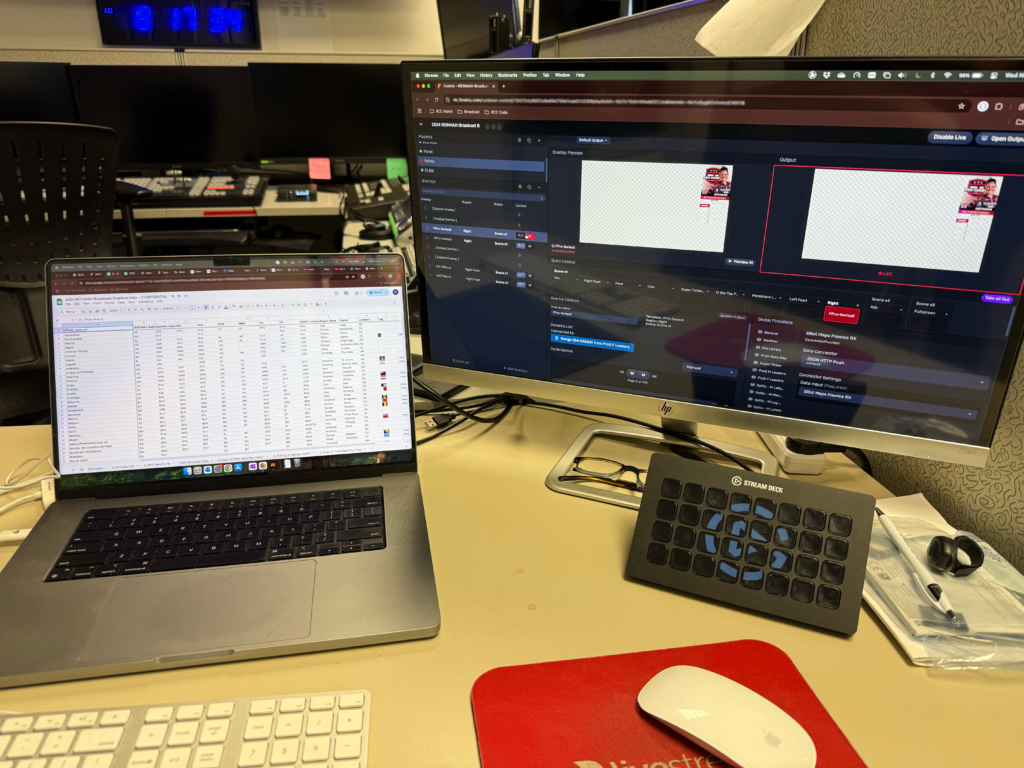Here We Go…
In the fast-paced world of live sports broadcasting, every second counts. From triathlon, to soccer or gravel racing… Our studio team must always be on our toes, ready for anything. For events as large and dynamic as IRONMAN races, a critical role behind the scenes is that of the Graphics Operator. At BCC Live, the Graphics Operator is responsible for creating and managing all the visual data that viewers see on their screens… From leaderboards to race analytics, sponsor integrations, and more. These elements don’t just enhance the broadcast; they help tell the story of the race.
From Signage to Screens: How Broadcasting Began
My journey into the world of graphics operation began in a place you might not expect… Designing and producing signage for large corporations. Working with national brands, I learned the importance of adhering to design criteria, brand guidelines, and local regulations. This experience, combined with my passion for endurance sports, ultimately led me to BCC Live, where I now oversee the visual elements of our IRONMAN broadcasts and other live broadcasts we produce.
Just like in signage, precision is key in broadcast graphics. I’ve come to rely heavily on tools like Adobe Illustrator for initial designs and asset management. This allows me to scale graphics seamlessly across resolutions and devices. Beyond the technical skills, what drew me to this role was the opportunity to use graphics as a storytelling tool—especially in long-form broadcasts like IRONMAN events and Gravel Worlds.

Designing the Broadcast for the Ultimate Race Day
The process of designing graphics for a broadcast starts with the client’s brand identity. At IRONMAN, we work closely with event organizers to make sure every element—from logos to color schemes—resonates with their audience. Whether it’s the Roka Swim Course or the Hoka Run Course, each branded segment not only reflects the larger IRONMAN identity but also provides sponsorship opportunities that sustain the broadcast. This methodology is applicable no matter the event. Whether it’s sports or a live conference broadcast, we ensure every element of the show helps us tell the story of the event.
Creating a graphics package involves more than just slapping logos on the screen. We design visual elements that guide viewers through the race—clocks, scrolling tickers, leaderboard updates, and even athlete bios and headshots. We carefully craft every element to engage viewers and keep them informed about race developments in real-time.

Engineering Systems for Precision and Efficiency
One of the most exciting aspects of my role is building the technical systems that make race-day graphics possible. Behind every graphic on screen is a network of software and hardware working in harmony. At BCC Live, we’ve developed a seamless system that allows us to pull real-time data from race timing platforms like RTRT, which gives us the ability to display timing splits, leaderboards, and estimated finish times with millisecond precision.
To make things even more efficient, we also use cloud-based tools like Viz Flowics. This HTML5 graphics solution allows us to render native elements directly on our NewTek Tricaster 2 Elite over the web as a buffer source, minimizing the need for imported assets. We’ve also integrated automation into our system with devices like the Elgato Stream Deck, enabling operators to trigger graphics at the press of a button.
TThis focus on simplicity and scalability ensures that, even in the heat of a live broadcast, any operator—whether a seasoned expert or a first-timer—can manage our intuitive system.
Operating Graphics During the Broadcast on Event Day
On race week, the real work begins. In the days leading up to the race, I prepare by loading all the pre-set libraries specific to the event. This includes setting the race or event name, location, athlete information including start lists, speaker information, bib numbers, country codes and flags, swim cap colors, and any sponsorship obligations. Once the event begins, my job is to ensure that all graphics are synced with the live action, and to ensure a seamless viewing experience.
Some elements, like the scrolling ticker of leaderboard results, are automated, pulling data directly from platforms like RTRT. We manually trigger other elements, like athlete IDs or sponsor spots, based on what’s happening on the course. With IRONMAN events lasting upwards of 10 hours, the graphics need to be updated constantly to reflect the action.
One of the biggest challenges we face is managing the story-telling when traditional timing systems may not update as often as we like. While timing mats are reliable, they only update at specific points on the course… Meaning that a lot can happen between checkpoints. We’re constantly working to improve how we display these live updates, and aim to give viewers the best sense of where the athletes are in real-time.

Why Graphics Matter in Live Sports Broadcasts
At the end of the day, the graphics aren’t just there to look good… They’re there to help tell the story of the race. In an IRONMAN or long distance cycling broadcast, where viewers might tune in and out throughout the day, it’s crucial that the on-screen information provides a clear snapshot of the race’s progress at any given moment.
Graphics are also key to maintaining the broadcast’s commercial viability. We integrate sponsors into the race narrative to create value for both the viewers and the brands involved. Whether it’s displaying the “First Out of the Water presented by Wahoo” or the “Hoka Run Course,” our graphics packages create a cohesive, branded experience that resonates with both the athlete community and corporate partners.
Looking Ahead: The Future of Graphics in Live Broadcasting
As we look to the future, the role of the Graphics Operator will continue to evolve alongside advancements in technology. At BCC Live, we’re already pioneering new tools like AI-powered race analytics and enhanced GPS tracking systems to deliver even richer data to viewers. We’re also constantly refining our systems to be more intuitive and efficient… Making it easier than ever to produce high-quality broadcasts.
What keeps me passionate about this work is the constant drive to innovate and push the boundaries of what’s possible. Every race presents a new challenge… And with it, a new opportunity to create graphics that enhance the viewer experience in fresh and exciting ways.
Want To Learn More About BCC Live’s Broadcast Roles?
Exclusive Glimpse Behind The Broadcast Desk – Master Of Multitasking
Switching Up the Game: Live Broadcast Technical Director

